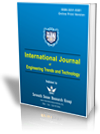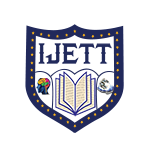Characterization of Alcohol Water Mixture Using Ensemble Machine Learning Method
Characterization of Alcohol Water Mixture Using Ensemble Machine Learning Method |
||
 |
 |
|
| © 2025 by IJETT Journal | ||
| Volume-73 Issue-2 |
||
| Year of Publication : 2025 | ||
| Author : Thushara Haridas Prasanna, Mridula Santha |
||
| DOI : 10.14445/22315381/IJETT-V73I2P121 | ||
How to Cite?
Thushara Haridas Prasanna, Mridula Santha, "Characterization of Alcohol Water Mixture Using Ensemble Machine Learning Method," International Journal of Engineering Trends and Technology, vol. 73, no. 2, pp. 244-252, 2025. Crossref, https://doi.org/10.14445/22315381/IJETT-V73I2P121
Abstract
Material characterization is important to ensure the quality of composites. Traditional methods for assessing alcohol content involve intricate chemical processes. Complex permittivity measurement is a good method to characterize the composites. This paper focuses on binary polar liquid mixtures, particularly alcohol-water mixtures, essential in many industries. Characterizing dielectrics, such as polar liquids, is challenging due to their frequency dispersion. To address this challenge, the paper proposes an ensemble machine learning-based classification model that uses complex permittivity measurements and frequency to accurately identify the type and volume fraction of alcohol in aqueous solutions. This model offers an accuracy rate of 98.4% and can accommodate a measurement error of ±5.5%. This approach simplifies assessing aqueous alcohol solutions and can serve as a supporting tool for various measurement systems.
Keywords
Composites, Complex permittivity, Classification, Identification, Polar liquids.
References
[1] Suresh C. Mehrotra, Ashok Kumbharkhane, and Ajay Chaudhari, Binary Polar Liquids: Structural and Dynamic Characterization Using Spectroscopic Methods, Elsevier, pp. 1-6, 2017.
[Google Scholar] [Publisher Link]
[2] Jian‐Zhong Bao, Mays L. Swicord, and Christopher C. Davis, “Microwave Dielectric Characterization of Binary Mixtures of Water, Methanol, and Ethanol,” The Journal of Chemical Physics, vol. 104, no.12, pp. 4451-4450, 1996.
[CrossRef] [Google Scholar] [Publisher Link]
[3] A.P. Gregory, R.N. Clarke, and M.G. Cox, “Traceable Measurement of Dielectric Reference Liquids Over the Temperature Interval 10-50 C Using Coaxial-Line Methods,” Measurement Science and Technology, vol. 20, no. 7, 2009.
[CrossRef] [Google Scholar] [Publisher Link]
[4] Rammah Ali Alahnomi et al., “Review of Recent Microwave Planar Resonator-Based Sensors: Techniques of Complex Permittivity Extraction, Applications, Open Challenges and Future Research Directions,” Sensors, vol. 21, no. 7, pp. 1-38, 2021.
[CrossRef] [Google Scholar] [Publisher Link]
[5] Gary Spedding, “Alcohol measurements: Chromatography (Gas Chromatography-GC and GC-Mass Spectroscopy, High Performance Liquid Chromatography-HPLC); Densitometry; Enzymatic and Spectroscopic (Near-Infrared - NIR and Nuclear Magnetic Resonance - NMR) Methods: A Brief Review,” Brewing and Distilling Analytical Services, LLC WPSP, pp. 1-6, 2015.
[Google Scholar] [Publisher Link]
[6] Chunmiao Han et al., “Structure Study of Water in Alcohol-Water Binary System Based on Raman Spectroscopy,” Journal of Physics: Conference Series, International Conference on Applied Mathematics and Physics, Sanya, China, vol. 2282, no. 1, pp. 1-7, 2022.
[CrossRef] [Google Scholar] [Publisher Link]
[7] Qin Dong et al., “Near-Infrared Spectroscopic Study of Molecular Interaction in Ethanol-Water Mixtures,” Spectrochimica Acta Part A: Molecular and Biomolecular Spectroscopy, vol. 222, 2019.
[CrossRef] [Google Scholar] [Publisher Link]
[8] P. Petong, R. Pottel and U. Kaatze, “Water-Ethanol Mixtures at Different Compositions and Temperatures, A Dieletric Relaxation Study, The Journal of Physical Chemistry A, vol. 104, no. 32, pp. 7420-7428, 2000.
[CrossRef] [Google Scholar] [Publisher Link]
[9] R.L. Smith et al., “Relative Permittivity and Dielectric Relaxation in Aqueous Alcohol Solutions,” Fluid Phase Equilibria, vol. 144, no. 1-2, pp. 315-322, 1998.
[CrossRef] [Google Scholar] [Publisher Link]
[10] Davide Bertolini et al., “Dielectric Relaxation in Binary Solutions: Theory and Experimental Results,” The Journal of Chemical Physics, vol. 108, no. 15, pp. 6416-6430, 1998.
[CrossRef] [Google Scholar] [Publisher Link]
[11] V. Ya Gotsulskiy, N.P. Malomuzh, and V.E. Chechko, “Particular Points of Water-Alcohol Solutions,” Russian Journal of Physical Chemistry A, vol. 89, pp. 207-213, 2015.
[CrossRef] [Google Scholar] [Publisher Link]
[12] Paul H. Chamberlain, “Identification of an Alcohol with 13C NMR Spectroscopy,” Journal of Chemical Education, vol. 90, no. 10, pp. 1365-1367, 2013.
[CrossRef] [Google Scholar] [Publisher Link]
[13] A.P. Gregory, and R.N. Clark, “A Review of RF and Microwave Techniques for Dielectric Measurements on Polar Liquids,” IEEE Transactions on Dielectrics and Electrical Insulation, vol. 13, no. 4, pp. 727-743, 2006.
[CrossRef] [Google Scholar] [Publisher Link]
[14] Yan‐Zhen Wei, and S. Sridhar, “Technique for Measuring the Frequency‐Dependent Complex Dielectric Constants of Liquids up to 20 GHz,” Review of Scientific Instruments, vol. 60, no. 9, pp. 3041-3046, 1989.
[CrossRef] [Google Scholar] [Publisher Link]
[15] Vladimir Naumovich Vapnik, Statistical Learning Theory, Wiley, pp. 1-736, 1998.
[Google Scholar] [Publisher Link]
[16] Alexander J. Smola, Bernhard Scholkopf, and Christopher J. C. Burges, Advances in Kernel Methods: Support Vector Learning, MIT Press, USA, pp. 1-376, 1999.
[Google Scholar] [Publisher Link]
[17] Pelin Yildirim Taser, Gulnur Onsal, and Onur Ugurlu, “Comparison of Experimental Measurements and Machine Learning Predictions of Dielectric Constant of Liquid Crystals,” Bulletin of Materials Science, vol. 46, no. 1, 2022.
[CrossRef] [Google Scholar] [Publisher Link]
[18] Ebru Efeoglu, and Gurkan Tuna, “The Use of Microwave and K* Algorithm in Determination of Alcohol Concentration in Liquids,” Russian Journal of Nondestructive Testing, vol. 56, no. 8, pp. 689-697, 2020.
[CrossRef] [Google Scholar] [Publisher Link]
[19] Zhizhong Si et al., “2D Material Property Characterizations by Machine-Learning-Assisted Microscopies,” Applied Physics A, vol. 129, no. 4, 2023.
[CrossRef] [Google Scholar] [Publisher Link]
[20] Satheesh Abimannan et al., “Ensemble Multifeatured Deep Learning Models and Applications: A Survey,” IEEE Access, vol. 11, pp. 107194-107217, 2023.
[CrossRef] [Google Scholar] [Publisher Link]
[21] Xibin Dong et al., “A Survey on Ensemble Learning,” Frontiers of Computer Science, vol. 14, pp. 241-258, 2020.
[CrossRef] [Google Scholar] [Publisher Link]
[22] Alok Kumar and Mayank Jain, Ensemble Learning for AI Developers, 1st ed., Apress, pp. 1-136, 2020.
[CrossRef] [Google Scholar] [Publisher Link]
[23] Ibomoiye Domor Mienye, and Yanxia Sun, “A Survey of Ensemble Learning: Concepts, Algorithms, Applications and Prospects,” IEEE Access, vol.16, pp. 99129-149, 2022.
[CrossRef] [Google Scholar] [Publisher Link]
[24] Yongquan Yang, Haijun Lv, and Ning Chen, “A Survey on Ensemble Learning Under the Era of Deep Learning,” Artificial Intelligence Review, vol. 56, no. 6, pp. 5545-5589, 2023.
[CrossRef] [Google Scholar] [Publisher Link]
[25] Yong Liu et al., “Ensemble Learning-Based Technique for Force Classifications in Piezoelectric Touch Panels,” IEEE Sensors Journal, vol. 20, no. 16, pp. 9450-9459, 2020.
[CrossRef] [Google Scholar] [Publisher Link]
[26] Wenzhe Ding et al., “A Novel Method for Damage Prediction of Stuffed Protective Structure Under Hypervelocity Impact by Stacking Multiple Models,” IEEE Access, vol. 14, no. 18, pp. 130136-130138, 2020.
[CrossRef] [Google Scholar] [Publisher Link]
[27] Shaoze Cui et al., “A Stacking-Based Ensemble Learning Method for Earthquake Casualty Prediction,” Applied Soft Computing, vol. 101, 2021.
[CrossRef] [Google Scholar] [Publisher Link]
[28] Yuyan Wang et al., “Stacking-Based Ensemble Learning of Decision Trees for Interpretable Prostate Cancer Detection,” Applied Soft Computing, vol. 77, pp. 188-204, 2019.
[CrossRef] [Google Scholar] [Publisher Link]
[29] Ahmed Salim et al., “Simplified Approach to Detect Dielectric Constant Using a Low-Cost Microfluidic Quarter Mode Substrate-Integrated Waveguide,” Sensors, vol. 20, no. 17, pp. 1-15, 2020.
[CrossRef] [Google Scholar] [Publisher Link]
[30] Vangala Rama Vyshnavi, and Amit Malik, “Efficient Way of Web Development Using Python and Flask,” International Journal of Recent Research Aspects, vol. 6, no. 2, pp. 16-19, 2019.
[Google Scholar] [Publisher Link]

